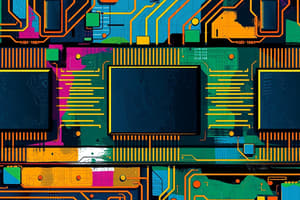Podcast
Questions and Answers
In a programmed I/O system, the processor is responsible for storing data in main memory for input.
In a programmed I/O system, the processor is responsible for storing data in main memory for input.
True (A)
Interrupt-driven I/O is more efficient than programmed I/O because it keeps the processor busy needlessly.
Interrupt-driven I/O is more efficient than programmed I/O because it keeps the processor busy needlessly.
False (B)
Direct Memory Access (DMA) allows I/O devices to transfer data to and from main memory without involving the processor.
Direct Memory Access (DMA) allows I/O devices to transfer data to and from main memory without involving the processor.
True (A)
In a single-processor system, the processor can execute multiple programs concurrently.
In a single-processor system, the processor can execute multiple programs concurrently.
Memory management techniques, such as paging and segmentation, are only used in multi-processor systems.
Memory management techniques, such as paging and segmentation, are only used in multi-processor systems.
Direct Memory Access (DMA) is used for low-speed I/O devices.
Direct Memory Access (DMA) is used for low-speed I/O devices.
DMA transfers blocks of data from CPU directly to main memory without CPU intervention.
DMA transfers blocks of data from CPU directly to main memory without CPU intervention.
Processor generates one interrupt per byte during DMA transfer.
Processor generates one interrupt per byte during DMA transfer.
DMA is not efficient for movement of large volumes of data.
DMA is not efficient for movement of large volumes of data.
The processor is only involved at the beginning of the DMA transfer.
The processor is only involved at the beginning of the DMA transfer.
DMA sends an interrupt signal to the processor when the transfer is incomplete.
DMA sends an interrupt signal to the processor when the transfer is incomplete.
In a single-processor system, Direct Memory Access (DMA) allows I/O devices to transfer data directly to and from main memory without the involvement of the CPU.
In a single-processor system, Direct Memory Access (DMA) allows I/O devices to transfer data directly to and from main memory without the involvement of the CPU.
The cache management policy determines the order in which cache lines are evicted from the cache when it is full, and a new line needs to be brought in, $\frac{1}{2} \times \sqrt{4} = 1$.
The cache management policy determines the order in which cache lines are evicted from the cache when it is full, and a new line needs to be brought in, $\frac{1}{2} \times \sqrt{4} = 1$.
In a computer system, the access time for main memory is typically slower than the access time for cache memory but faster than the access time for secondary storage devices like hard disk drives.
In a computer system, the access time for main memory is typically slower than the access time for cache memory but faster than the access time for secondary storage devices like hard disk drives.
In a single-processor system, the CPU must be involved in all data transfers between main memory and I/O devices, even when using Direct Memory Access (DMA).
In a single-processor system, the CPU must be involved in all data transfers between main memory and I/O devices, even when using Direct Memory Access (DMA).
The principle of caching involves temporarily copying frequently accessed data from slower storage to faster storage to improve access times, and it is implemented at various levels in a computer system.
The principle of caching involves temporarily copying frequently accessed data from slower storage to faster storage to improve access times, and it is implemented at various levels in a computer system.
In a single-processor system with DMA, the CPU is responsible for initiating the DMA transfer, but the actual data transfer occurs without the involvement of the CPU.
In a single-processor system with DMA, the CPU is responsible for initiating the DMA transfer, but the actual data transfer occurs without the involvement of the CPU.
Flashcards are hidden until you start studying
Study Notes
Direct Memory Access (DMA)
- Used for high-speed I/O devices that can transmit information at close to memory speeds
- Device controller transfers blocks of data from buffer storage directly to main memory without CPU intervention
- Only one interrupt is generated per block, rather than one interrupt per byte
- Processor delegates the I/O operation to DMA for efficient movement of large volumes of data
- Performed by a separate module on the system
DMA Process
- Processor sends I/O request to DMA
- Processor grants I/O module authority to read from or write to memory
- DMA transfers a block of data directly to or from memory without processor involvement
- When transfer is complete, DMA sends an interrupt signal to the processor
- Processor is only involved at the beginning and end of the transfer, making it more efficient
Storage-Device Hierarchy
- Decreasing cost per bit, increasing capacity, increasing access time, and decreasing volatility as you go down the hierarchy
- Key success trade-off: Decreasing frequency of access to lower level
Performance of Various Levels of Storage
- Movement between levels of storage hierarchy can be explicit or implicit
Caching
- Important principle performed at many levels in a computer (in hardware, operating system, software)
- Information in use is copied from slower to faster storage temporarily
- Faster storage (cache) is checked first to determine if information is there
- If it is (hit), information is used directly from the cache (fast)
- If not (miss), data is copied to cache and used there
- Cache is smaller than storage being cached
Cache Management
- Important design problem
- Cache size and replacement policy are critical considerations
I/O Structure
- Three techniques are possible for I/O operations: Programmed I/O, Interrupt-driven I/O, and Direct Memory Access (DMA)
Programmed I/O
- Processor sends request to I/O module and waits for completion
- I/O module performs the action and sets bits in the I/O status register
- Processor must keep checking status, extracting data from main memory for output, and storing data in main memory for input
- Disadvantage: Keeps the processor busy needlessly
Interrupt-Driven I/O
- Processor issues an I/O command to a module and then goes on to do some other useful work
- Processor is interrupted when I/O module is ready to exchange data
- Processor is free to do other work, making it more efficient than Programmed I/O
- Disadvantage: Consumes a lot of processor time because every word read or written passes through the processor
Studying That Suits You
Use AI to generate personalized quizzes and flashcards to suit your learning preferences.




